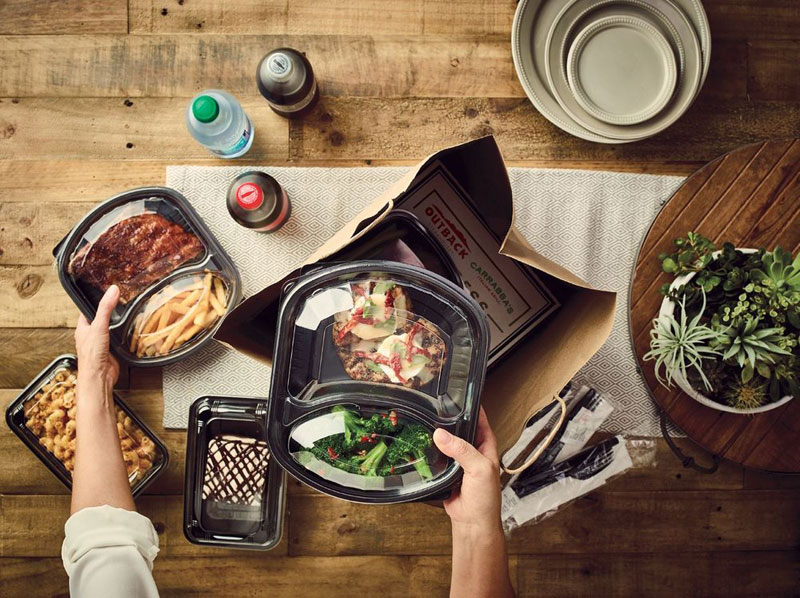As casual-dining chains saw traffic decline over the past decade, many began turning to delivery as a way to draw customers and boost off-premise sales. It’s a strategy that’s showing results and some companies are doubling down on what’s becoming not merely an industry trend but a fundamental shift in how restaurants operate.
At its Outback Steakhouse and Carrabba’s Italian restaurants, parent Bloomin’ Brands is bringing more locations to its online delivery program as it looks to replicate the success it’s seeing at most of the 240 restaurants where delivery is currently offered.
“It is becoming increasingly evident that the potential for off-premise and delivery provides a large and incremental tailwind for casual dining,” said Elizabeth Smith, CEO and chairwoman of Tampa, Florida-based Bloomin’. The company also owns Bonefish Grill and Fleming’s Prime Steakhouse & Wine Bar, but has focused its delivery efforts on Outback and Carrabba’s, including launching five delivery/takeout-only Express units that combine the two brands.
During Bloomin’ Brands second-quarter earnings call July 30, Smith said the majority of its existing delivery locations hit targeted metrics including delivery time and deliveries per location.
“And as a result, we are now resuming our rollout of delivery to another 200 locations,” she said. Together Outback and Carrabba’s have more than 900 locations in the U.S., and the company anticipates having this next phase completed by the end of the year.
Bloomin’ also plans to open another Outback/Carrabba’s Express unit, Smith said.
More marketing dollars are being funneled to digital platforms, including the company’s Dine Rewards loyalty program, which covers all four brands and has helped bolster off-premise orders by highlighting the multiple ways customers can experience the restaurants.
“The good news is we have a lot of opportunity in front of us now since we’ve made the data investments: We’ve built the data cloud; we’ve built the integrated customer profile,” said Smith, adding they’re now in a position to monetize these updates. “And we can use that database now and are using it to provide the relevant message at the right time regarding the right channel to our customers.”
Other casual brands follow suit—or don’t
BJ’s Restaurants and Brewhouse is another casual brand that’s focused on driving delivery sales. The company partnered early in 2017 with third-party delivery service DoorDash, and later with Grubhub. The Huntington Beach, California-based chain started an alcohol delivery program last fall to offset the decline in beverage sales as more people ordered food directly to their homes. Those moves are bringing results, noted CEO Greg Trojan during the company’s earnings call July 27.
“Our off-premise sales, including takeout, large-party catering and delivery, finished the quarter at a run rate of 7.6 percent of sales,” Trojan said. “And we believe there’s an opportunity to grow this channel by at least another 50 percent over the next several years.”
Instead of building its own delivery network, Trojan said they are working with delivery partners on “co-marketing and driving the awareness through some delivery offers.”
And while the initial expectation was that off-premise orders would be concentrated in urban, high-density areas, the reach is actually much wider, with demand coming from “every geography that we’ve enabled,” said Trojan. As BJ’s continues to keep a close eye on traffic and trends, Trojans said, they haven’t seen a relationship between growth in off-premise business and a “degradation in the growth of our on-premise business.”
Not all casual dining brands are jumping into delivery with both feet. At Big Whiskey’s American Restaurant & Bar, co-founder Paul Sundy said the company wants to be careful and deliberate in how it addresses taking its business outside the restaurant.
“We’re not just going to jump in to move the needle” on sales,” he said. “In our space, it’s the experience that make’s the difference and you don’t get that with delivery.”
Big Whiskey’s is testing packaging options and wants to ensure a “delivered product would be one that we’d like to get ourselves from our restaurants,” said Sundy.
“We’re positioned to do it when and if it makes sense to us.”
Scott Foster, executive chef and partner in Nova Restaurant Group, has an even stronger opinion.
“I hate takeout food, delivery—I can’t stand it. Your food deteriorates; it ends up just not reflecting well on the restaurant,” said Foster, who has seven full-service restaurants in Minnesota and earlier in his career was a executive chef with Lettuce Entertain You Restaurants, working on concepts such as Maggiano’s, Big Bowl and Twin City Grill.
While some of his restaurants do offer takeout, it’s restricted to off-peak times “because the people in our four walls are the most important,” and delivery isn’t in the game plan at all.
The NPD Group noted in its 2018 outlook for the foodservice industry that “the most popular place to eat out will be in the home,” but restaurant operators also need to understand there’s not a one-size-fits-all approach. Instead they must decide which of these convenience-enablers is worth their investment and then be able to fully execute on any initiatives.


